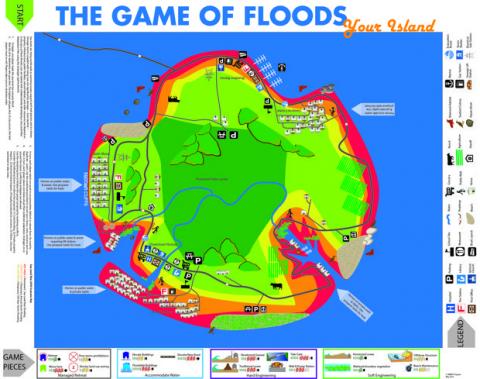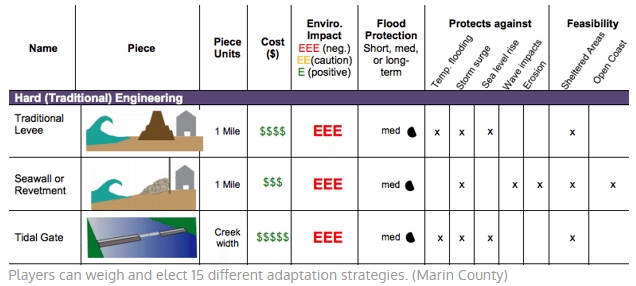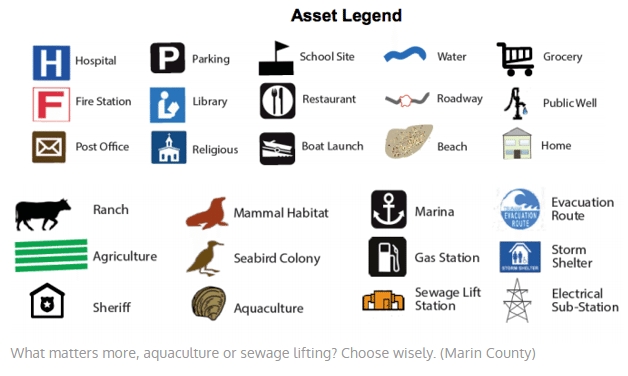
But who will build the Longest Flood Wall? ,Marin County
Super-high king tides hammered homes and roads in Marin County, California this past winter, and residents can expect worse as rising seas threaten to super-soak their lives. If nothing is done to adapt, highways and utility connections eight miles inland in the mostly rural Bay Area county could get doused within 15 years, on top of hundreds of buildings inundated closer to shore. Tens of thousands of residents could be affected.
So when Marin County wanted to invite the public into the process of planning for that hazardous future two years ago, officials decided to try something different. Enter “The Game of Floods,” a choose-your-own-hazard-mitigation romp created by a team of local public works engineers and planners. Climate change may have its winners and losers, but this game—which earned Marin County a national award for public outreach by the American Planning Association on Wednesday— focuses on the value of collaboration and small steps in the face of a huge challenge.
It visualizes what could happen in a community, and it gets people thinking about how choices have impacts.
Designed to be played at a community meeting or workshop, the Game of Floods invites residents to play the role of planning commissioners weighing adaptation strategies against the very wet future of a hypothetical “Marin Island.” It’s a resource-management game, in the style of Settlers of Catan. There’s a hexagonal playing board with colorfully mapped flood zones; players choose community “assets” that they commit to protecting, such as a seabird colony, a parking lot, or an electrical sub-station.
Designed to be played at a community meeting or workshop, the Game of Floods invites residents to play the role of planning commissioners weighing adaptation strategies against the very wet future of a hypothetical “Marin Island.” It’s a resource-management game, in the style of Settlers of Catan: There’s a hexagonal playing board with colorfully mapped flood zones; players choose community “assets” that they commit to protecting, such as a seabird colony, a parking lot, or an electrical sub-station.

A facilitator reads aloud a gloomy synopsis of sea-level rise’s impact on the island by 2050. Players think through strategies to accommodate, defend, or retreat from their chosen parcels, signaling their choices with some sweet stickers—a flood wall there, a zoning change there. A guide that outlines the costs, environmental trade-offs, and human impacts teaches them about the outcomes of their decisions. There aren’t individual victory points; the game is “won” after every player presents their visions to the rest of the group, which deliberates to choose the best overall strategy to protect the island. (Sorry, no “
Longest Flood Wall” here.)
Team deliberation can be tough, says Alex Westhoff, a planner with the Marin County Community Development Agency, but it helps residents grasp what planners are tasked with when weighing decisions themselves. “It’s the first adaptation game I’m aware of,” he says. “People definitely appreciate a fun and engaging approach to learning about this.”

“Fun” may not be the first word that comes to mind when planning for climate-change devastation. But Westhoff says the game succeeds in capturing players’ attention, because it transforms what can feel like an overwhelming reality—planet-wide sea-level rise—into a series of specific bite-sized actions.
After presenting it to West Marin workshop participants in 2015, county staffers took the game to a handful of conferences around California. It caught the attention of planners, universities, and preservation societies. Agencies in other flood-vulnerable states, as well as the EPA and FEMA, requested copies, too. By now, Westhoff estimates some 1,500 people have now played the game in workshops and classrooms around the U.S. With grant funding,
the county is turning the game’s print-it-yourself materials into a formal box set available for purchase by libraries and schools.
“It all boils down to getting a conversation started about a very important topic,” says Roberta Rewers, a senior communications coordinator for the APA. “It visualizes what could happen in a community, and it gets people thinking about how choices have impacts.”
Laura Bliss is a staff writer at CityLab.




Spread the word